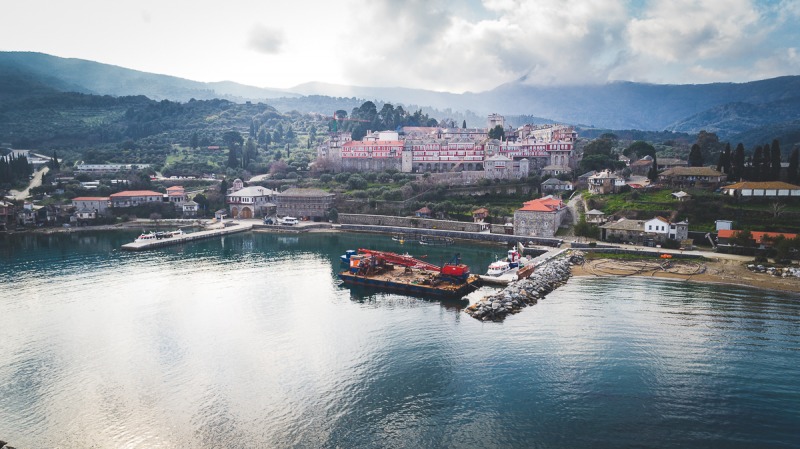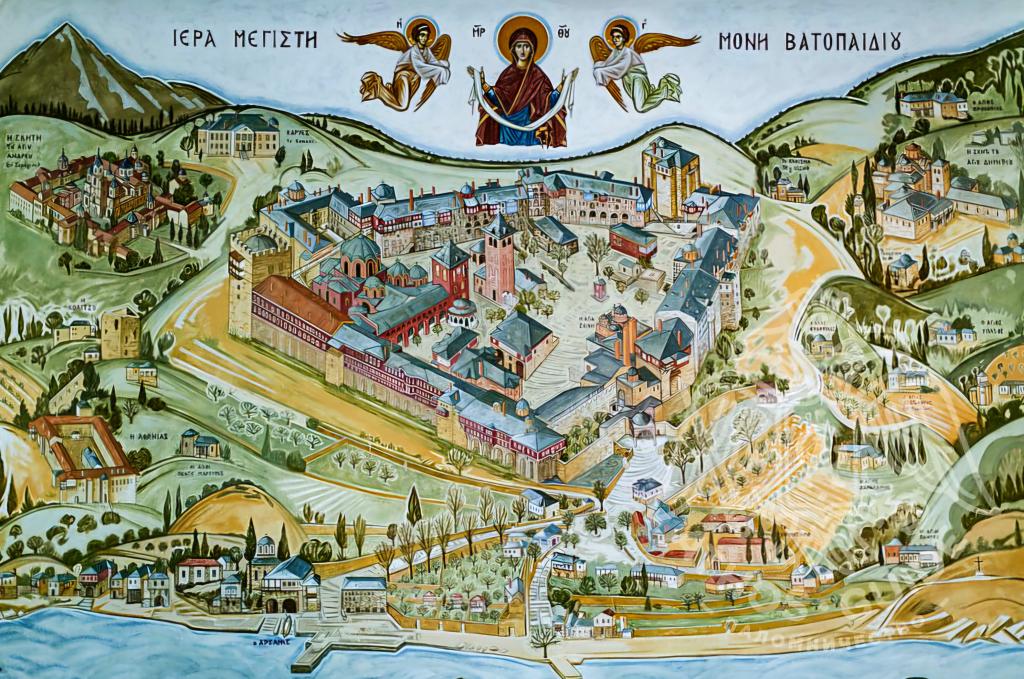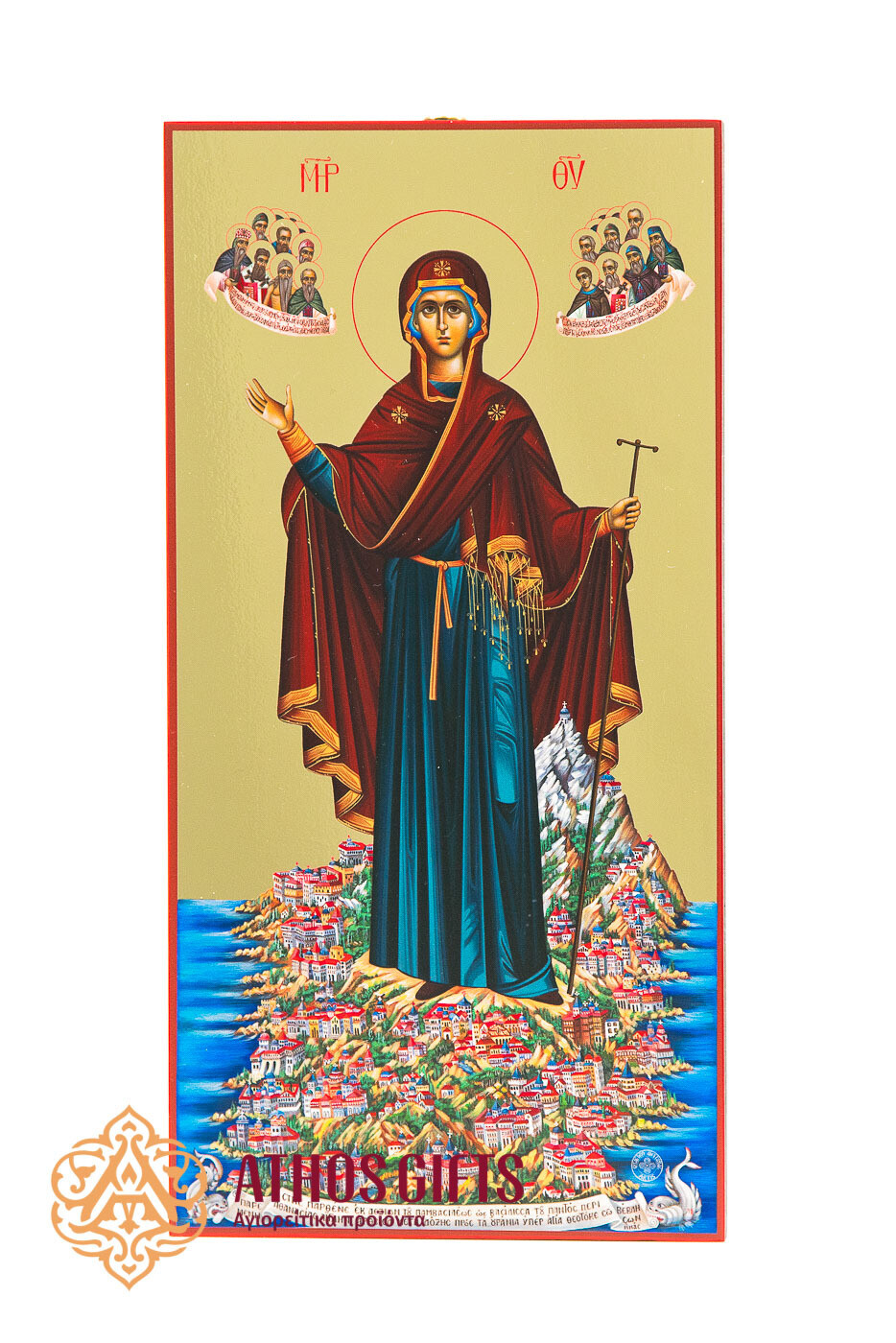
Mount Athos is the repository of the Orthodox Christian tradition. It is a place of theological and spiritual wealth. Its history highlights its importance. Orthodox Christians honor the sanctity of Athos and turn to it, placing their hopes in the humble prayers of the Athonite fathers.
One of the most distinctive features of the peninsula is the Avaton rule which governs the monastic state. It constitutes a rule that prohibits any female from entering Mount Athos and is enforceable by law. Although in the modern world this term often raises questions and objections, Orthodox thought approaches the Avaton with respect, attributing great spiritual and theological significance to the Garden of the Theotokos (Mother of God).

Why do we Call Athos the "Garden of the Theotokos"?
Mount Athos is referred to as the "Garden of the Theotokos" because of the theological link that connects this place with the Blessed Mother of God. The spiritual tradition of Athos regards the Mother of God as the supporter and protector of monastic state. Her motherly love is the crowning glory of the Athonite worship. The monks venerate Her, invoke Her holy name, and pray to Her. The multitude of Her holy icons, as well as the miracles She has performed, attest to her presence on the peninsula. The pristine beauty of Athos corresponds to the beauty of the Theotokos, who, as the protector of the place, covers and guards the monasteries.
According to tradition, the Mother of God chose Athos as a piece of land that She Herself would take care of. While travelling to Cyprus along with Saint John the Theologian, a fierce storm broke out. The strength of the wind forced them to stop their ship at the first shore they found on their way, and so they landed on the shores of Athos. The Theotokos loved the landscape, admired its natural riches, and asked Her Son to grant Her the land. In response to Her request, a voice was heard: "Let this land be Your lot and Your garden and Your paradise, and let it be a place of salvation for those wishing to be saved."
Thus, Mount Athos was called the Garden or the Lot of the Theotokos. She is considered the only woman, the protector of the monks and the Hegumeness of the Athonite land.
The History of the Avaton Rule
There are many stories that refer to the relationship between the Theotokos and Mount Athos and are linked to the Avaton rule. The most well-known and defining narrative concerns the arrival of the daughter of Emperor Theodosius the Great, Placidia, to the Athonite territory in the 5th century. Placidia was traveling from Rome to Constantinople to meet her brother Arcadius. Passing through Athos, she wished to stop and venerate the sanctity of the place.  The monks welcomed her outside the Holy Monastery of Vatopaidi. However, Placidia wanted to proceed inside the monastery and pray in the Catholicon. At that moment, the voice of the Most Holy Theotokos was heard saying: "What do you want here? Here are monks, and you are a woman. Why do you give the enemy a reason to tempt them with wicked thoughts? Stand still and do not proceed." Placidia stood in awe as she heard the Mother of God scolding her. She fell to her knees in repentance. She left the monastery and asked that a chapel be built on that site in memory of the miracle. Thus, the chapel of Saint Demetrios was built, where the Theotokos Antifonitria (One Who Replies), named after the miraculous event, is represented.
The monks welcomed her outside the Holy Monastery of Vatopaidi. However, Placidia wanted to proceed inside the monastery and pray in the Catholicon. At that moment, the voice of the Most Holy Theotokos was heard saying: "What do you want here? Here are monks, and you are a woman. Why do you give the enemy a reason to tempt them with wicked thoughts? Stand still and do not proceed." Placidia stood in awe as she heard the Mother of God scolding her. She fell to her knees in repentance. She left the monastery and asked that a chapel be built on that site in memory of the miracle. Thus, the chapel of Saint Demetrios was built, where the Theotokos Antifonitria (One Who Replies), named after the miraculous event, is represented.
Upon arriving in Constantinople and informing Arcadius, Placidia paved the way for the establishment of the Avaton (Restriction of Access) rule in Mount Athos. The emperor decreed the ban on women's entry. His decision was recognized by many following decrees of subsequent emperors, as well as by the stance of the monks and local populations. In the 10th century, the emperor John I Tzimiskes issued a chrysobull (golden bull) prohibiting the presence of women in the Athonite state.
During the Ottoman rule, the term of Avaton continued to be in effect. In fact, it was accepted by the Ottoman soldiers and officials who inhabited the Athonite land. When at some point they wanted to bring their wives to their dwellings within the Athonite territory, they faced the will of the Theotokos and her unwavering presence. Their superior, who had set out from Daphne to deliver the relevant document to the Ottoman authorities, was suddenly killed in an unexpected accident. From then on, Ottoman soldiers would say that “the Woman they have in Mount Athos does not allow their own women to reside there.”
Does the Avaton Apply to Female Animals?
The Avaton partially applies to the animals inhabiting the Athonite peninsula. The absence of females, within the broader application of the Avaton, extends to the livestock sector. There are, however, exceptions. For example, female cats live in Athos, as they are considered necessary for controlling mice. Occasionally, female birds, such as hens, which are necessary for egg production consumed by the monasteries, are also allowed.
The Avaton and its Theological Dimension
The Avaton was established through numerous miracles that took place in Athos. Primarily, it symbolizes the dedication of the place to the Most Holy Theotokos and is reinforced by legends related to Her figure. However, there are also practical reasons that impose respect towards the Athonite institution.
The Avaton is linked to the lives of the monks and their ascetic stance towards every aspect of human life. Among other things, it is associated with their desire to live in complete isolation from the outside world, to devote themselves entirely to prayer and the worship of our Lord Jesus Christ.
It's worth mentioning that Avaton is not an exclusively Athonite prohibition. This rule applies in many other monasteries, both male and female. Essentially, it is the prohibition of visiting monasteries by persons of the opposite sex. Considering that the entire land of Mount Athos is divided between its 20 monasteries and is inhabited exclusively by monks, the rule of Avaton does not seem extravagant or superfluous at all.
Since its founding, Mount Athos has had the character of an ascetic and hermit community. The monks who settled there sought to avoid any kind of temptation or action that would disrupt their relationship with God. Thus, the presence of women in a male monastic community was considered an obstacle to their spiritual path. Simultaneous presence of men and women was considered a risk of the downfall of the weak. At the same time, it was thought that the coexistence of the two sexes would give rise to comments and misunderstandings against monasticism. All of the above has been repeatedly emphasized by the holy fathers of our church and of Orthodox monasticism.
Legal and International Status
The Avaton of Mount Athos is legally regulated and protected. It is linked to the autonomous status of the monastic community and is recognized both by both Greek law and international treaties.
In the Charter of Mount Athos, according to Article 186, it is stipulated that:
"The entry of females into the peninsula of Mount Athos, according to the long-standing custom, is prohibited."

The same regulation is established and protected by the Greek state through the legislative decree F.E.K. 268/28.9.1953. In the European community, although the prohibition of women entering a place within the European territory caused opposition, it was nevertheless accepted. Declaration No. 8 of the final act of the Amsterdam Treaty confirmed the Athonite regulation, which was justified by religious and spiritual factors.
Modern Challenges and Perspectives
In modern times, new questions and challenges often arise. The touristic movement, the increased interest of believers in Mount Athos, and the easy access they can now have to the peninsula give rise to a broader concern. The monastic community faces the following dilemma: how to preserve its religious and spiritual heritage, while at the same time being forced to adapt to the pressures of modern society.
Particular concern arises from the entry of technology into all aspects of human life. Modern communication possibilities make the isolation of the monks increasingly difficult. The introduction of technological means in Athos has enabled them to effortlessly communicate with the outside world, which can easily distort the spiritual isolation required by monastic life.
Summary
The Avaton of Mount Athos remains part of a strong tradition deeply rooted in the history of this place. By Orthodox Christians it is considered a symbol of the sanctity of the monasteries and the special relationship of Athos with the Most Holy Theotokos.
However, the balance between tradition and the modern demands of society is delicate. The holy community of Mount Athos is called upon to find new ways to preserve the sanctity of monastic life while responding to the challenges and needs of the 21st century.


